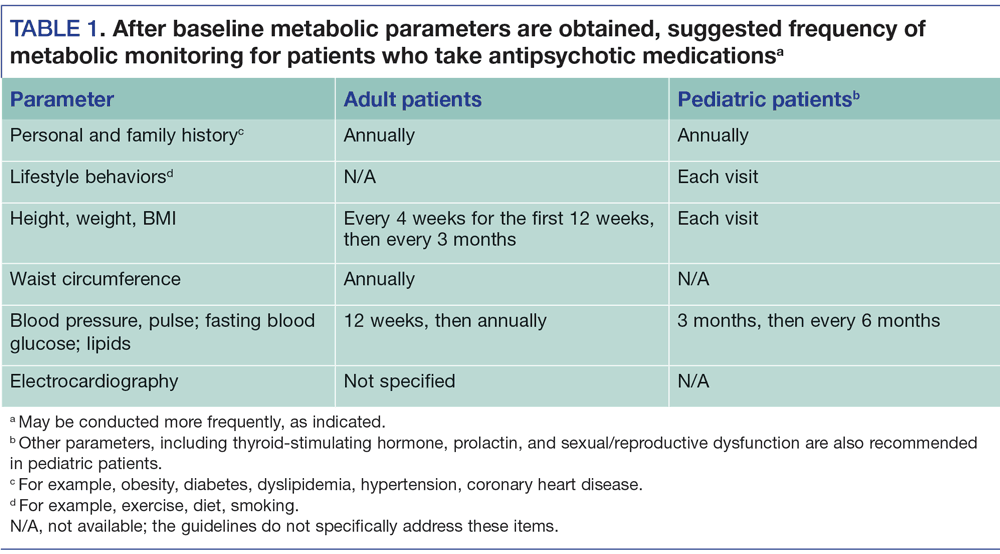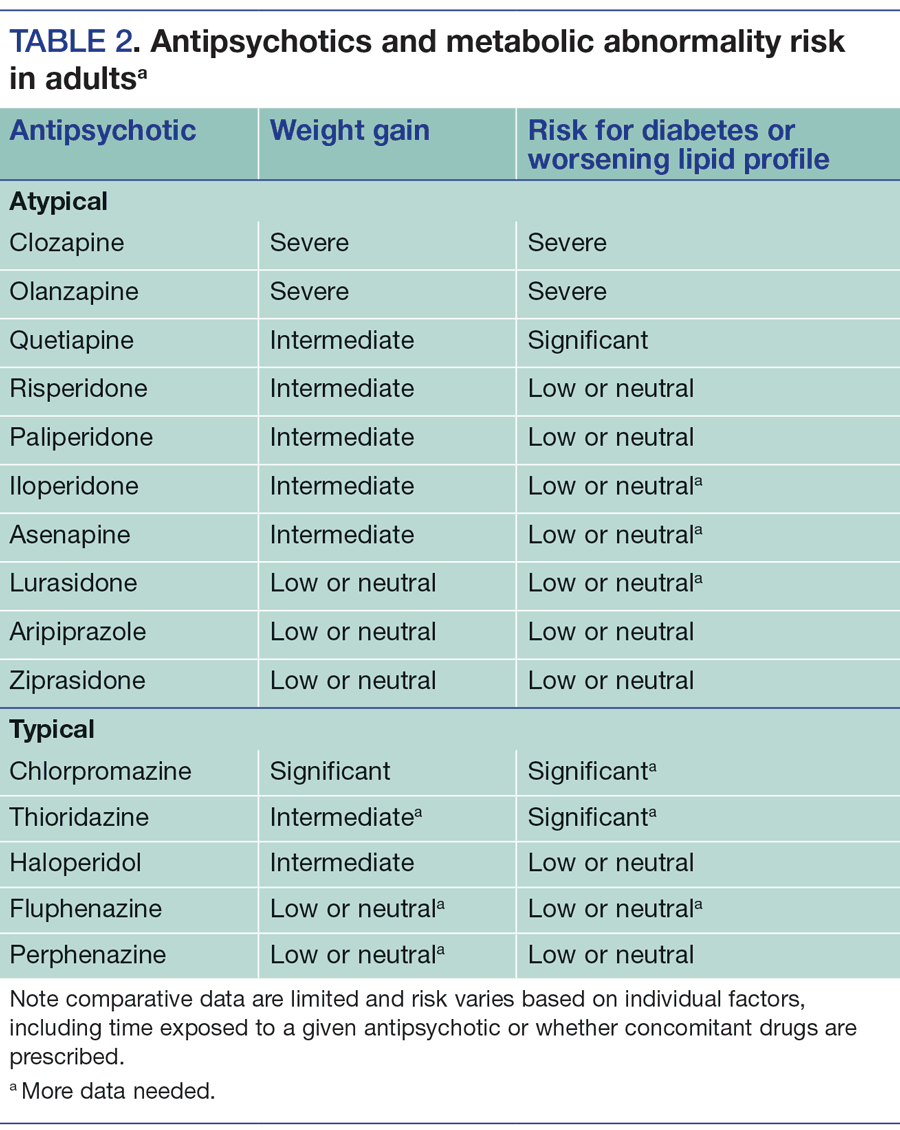Metabolic Monitoring of Antipsychotic Medications: What Psychiatrists Need to Know
Because patients who have psychiatric illnesses typically receive less frequent medical care, psychiatrists must aim to ensure appropriate monitoring of metabolic parameters when antipsychotic medications are used.
Table 1

Table 2

Metabolic adverse effects, including alterations in glucose metabolism, lipid abnormalities, and weight gain, are of great concern for patients treated with antipsychotic medications. These metabolic effects may occur in any patient, but are particularly concerning in children and adolescents, in drug-naive patients, or in patients with first-episode schizophrenia. The alterations seen in glucose metabolism include hyperglycemia, type 2 diabetes mellitus, or diabetic ketoacidosis and coma; whereas hypercholesterolemia, hypertriglyceridemia, and low high-density lipoprotein cholesterol level are possible lipid abnormalities associated with antipsychotic use.
Despite varying degrees of risk of alterations in metabolic parameters, it is important to emphasize that all antipsychotic agents pose a higher risk of clinically significant weight gain (greater than or equal to 7% of baseline body weight) than placebo.1 Antipsychotic medications are not the only factor that results in metabolic effects, as patients with severe mental illness are at increased risk for these abnormalities because of lifestyle choices and limited access to and participation in medical care.
Collectively, these effects are even more concerning because they are components of the metabolic syndrome and are associated with up to a 6-fold increase in the risk of type 2 diabetes and death from coronary heart disease.1,2 Despite these risks and the increased need for monitoring in this population, patients who have psychiatric illnesses typically receive less frequent medical care. In some cases, psychiatrists may be the only clinicians who manage a psychiatric patient’s care, and therefore they must aim to ensure appropriate monitoring of metabolic parameters when antipsychotic medications are used. Furthermore, consultation with other providers, including pharmacists, may be necessary to optimize the monitoring and management of these metabolic parameters according to established recommendations. Parameters are checked at baseline and at every follow-up visit in both adult and pediatric patients who receive antipsychotic medications (Table 1).
It is important to recognize the physical and psychological consequences of adverse effects associated with treatment nonadherence. An understanding of the differences between the metabolic risks with each antipsychotic may help guide medication selection so that the risks versus the benefits can be appropriately evaluated and treatment nonadherence can be minimized. Note that no single mechanism explains any of the metabolic effects seen with antipsychotic medications. Histamine, serotonin, dopamine, and muscarinic receptors, along with several others, are thought to play a role in these adverse effects. Lipid abnormalities can be independent of weight gain, and switching to an antipsychotic with lower metabolic risk may not lead to weight loss. Table 2 compares the risks of metabolic abnormalities among various antipsychotics based on available evidence in adults. While there are limitations to available data, this may be used as a guide for prescribers when selecting an agent.
While monitoring of atypical antipsychotics for metabolic effects has been well studied, there is controversy surrounding the need to monitor typical antipsychotics for the same effects. Leucht and colleagues3 conducted a meta-analysis that demonstrates the need to eliminate the dichotomy between typical and atypical antipsychotics with regard to potential weight gain. One finding suggests that if a patient is treated with chlorpromazine, a low-potency typical antipsychotic, the risk of weight gain is greater than with quetiapine and nearly similar to that of clozapine.
Bak and colleagues4 highlight the extent of clinically significant weight gain seen with haloperidol, particularly after long-term treatment. However, many published monitoring guidelines focus solely on atypical antipsychotics and do not explicitly mention monitoring typical antipsychotics. Leucht and colleagues3 emphasize that this needs to be addressed, as differences in risk should be better highlighted in clinical practice guidelines.
Following existing guidelines focused on typical antipsychotics, which may minimize the risks associated with these agents, has the potential to lead to negative patient outcomes. Because of the increased risk of premature death or metabolic complications among patients with serious mental illness as well as the frequently inadequate medical care they receive, it is prudent to monitor both typical and atypical antipsychotic drugs similarly. However, cost-effectiveness should be considered based on the individual patient and the specific antipsychotic used.
There are numerous reasons why antipsychotic medications are insufficiently monitored, including inadequate adherence to monitoring guidelines, lack of patient/caregiver education and understanding, and the inconvenience of obtaining laboratory test results. Despite these barriers to routine metabolic monitoring, reasonable action can be taken to overcome these obstacles. For example, engaging patients or their caregivers in a self-management strategy to enhance their own monitoring can be valuable. Ensuring patients have a scale, blood glucose monitor, or blood pressure cuff at home-as appropriate-can help engage and encourage healthy behaviors and monitoring. Keep in mind that attaining these laboratory parameters in a fasting state is no longer required, because non-fasting low-density lipoprotein cholesterol laboratory tests are available and measurement of hemoglobin A1c is considered an acceptable diagnostic tool for diabetes. Ordering laboratory tests in a timely manner and communicating these expectations with the patient and/or caregiver during the visit may help to increase patient adherence.
Finally, close collaboration with primary care providers and/or pharmacists can prove valuable-whether sharing results or developing a management plan (ie, recommending pharmacotherapy to mitigate risks) when laboratory parameters are abnormal. More specifically, for patients who should be maintained on their current antipsychotic given the risk of psychotic relapse, statins may be considered based on the individual’s cardiac risk group according to the 2013 American College of Cardiology/American Heart Association guidelines when aberrant lipid parameters are present.
Disclosures:
Dr. Bostwick is Associate Chair and Clinical Associate Professor, Department of Clinical Pharmacy, University of Michigan College of Pharmacy and Clinical Pharmacist in Psychiatry, Michigan Medicine, Ann Arbor; Dr. Murphy is Clinical Pharmacy Specialist – Mental Health, VA Ann Arbor Healthcare System. The authors report no conflicts of interest concerning the subject matter of this article.
References:
1. De Hert M, Detraux J, van Winkel R, et al. Metabolic and cardiovascular adverse effects associated with antipsychotic drugs. Nat Rev Endocrinol. 2011;8:114-126.
2. American Diabetes Association, American Psychiatric Association, American Association of Clinical Endocrinologists, North American Association for the Study of Obesity. Consensus development conference on antipsychotic drugs and obesity and diabetes. Diabetes Care. 2004;27:596-601.
3. Leucht S, Cipriani A, Spineli L, et al. Comparative efficacy and tolerability of 15 antipsychotic drugs in schizophrenia: a multiple-treatments meta-analysis. Lancet. 2013;382:951-962.
4. Bak M, Fransen A, Janssen J, et al. Almost all antipsychotics result in weight gain: a meta-analysis. PLoS One. 2014;9:e94112.
